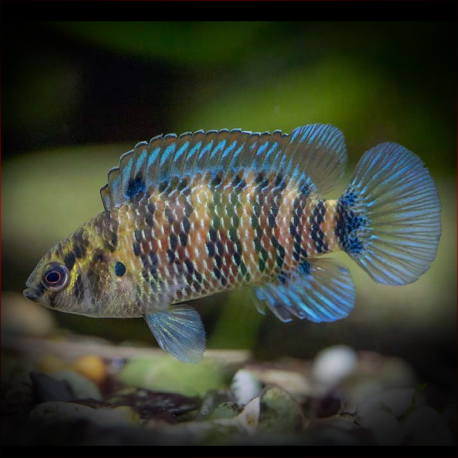More info
Datasheet
| Minimum Tank Size | 60 litres / 15.85 US gallons |
| Maximum Size | 6.0cm / 2.36inches |
| Temperature | 22°C / 71.60°F - 26°C / 78.80°F |
| Hardness | 2.02dgH / 36ppm - 12.05dgH / 215ppm |
| pH | 6.5-7.5 |
General Description
The Badis Khwae, a species within the Badidae family, is native to the Khwae Noi River basin in western Thailand, particularly in small streams that feed the main river. This fish can reach a maximum size of around 6.0cm and is known for its poor documentation and limited popularity in the aquarium hobby, mainly due to its restricted natural distribution.
Aquarium Setup
When setting up an aquarium for the Badis Khwae, a tank size of at least 60 litres is recommended. The species thrives in well-structured environments with a substrate of sand or gravel and plenty of water-worn rocks, pebbles, driftwood, and vegetation for cover. Adding plant species such as Microsorum, Taxiphyllum, or Anubias can further enhance the tank, while cave-like structures should be included to serve as potential spawning sites. The water parameters should be maintained within a pH range of 6.5-7.5, hardness of 36-215ppm, and a temperature between 22-26°C (see table for more details).
Behaviour
The Badis Khwae is not a gregarious fish and, in captivity, emphasis should be on captive reproduction rather than keeping it in groups. Rival males can display aggression towards each other, especially in smaller tanks, making it essential to provide sufficient space for each male to establish a territory. When housed in a community tank, tankmates should be chosen with care to ensure that the Badis Khwae is not intimidated or outcompeted for food.
Feeding and Diet
As micropredators, Badis Khwae species feed on small aquatic crustaceans, worms, insect larvae, and zooplankton. They may be picky eaters in captivity and might not accept dried foods initially, although they can be trained to consume them over time. Offering regular meals of small live or frozen foods like Artemia, Daphnia, or bloodworms is crucial to maintain their color and overall condition. Care should be taken to avoid feeding them chironomid larvae (bloodworm) or Tubifex, as these can lead to obesity and increased susceptibility to diseases.
Reproduction & Dimorphism
Badis Khwae are cave spawners that form temporary pair bonds during breeding. Males become considerably more colorful than females in spawning condition, with a white edge on their dorsal fin. Spawning can usually yield 30-100 eggs, with the male taking sole responsibility for caring for the eggs and fry, defending the territory and fanning the brood. The young fry may become free swimming after 6-8 days and should be provided with appropriate food such as microworms and Artemia nauplii.
Habitat and Distribution
In its natural habitat, the Badis Khwae is commonly found in sluggish to moderately-flowing streams with turbid or clear water, usually in shallow areas surrounded by forest vegetation. One population was even discovered in a reservoir with very clear, cold water and dense aquatic vegetation. The species is endemic to the Khwae Noi River basin in western Thailand, close to the border with Myanmar, where it resides in small streams that feed into the main river.

